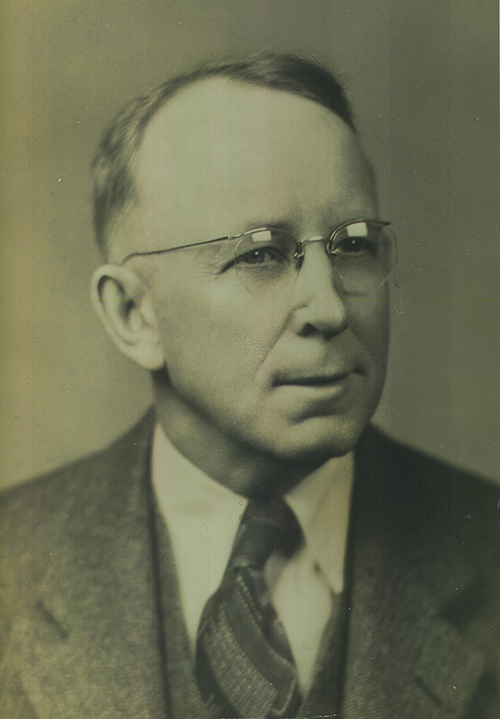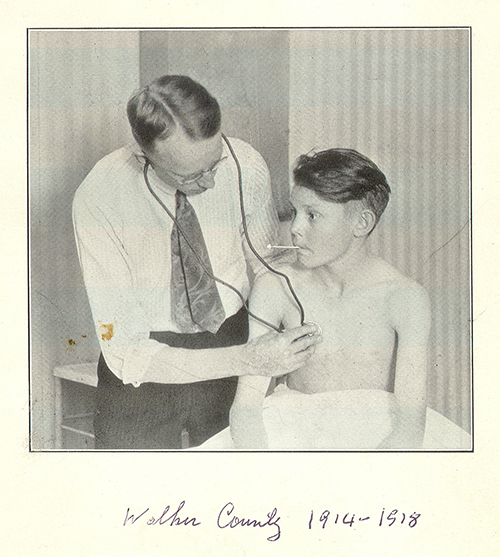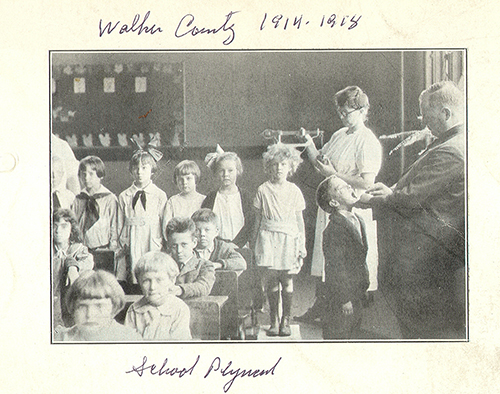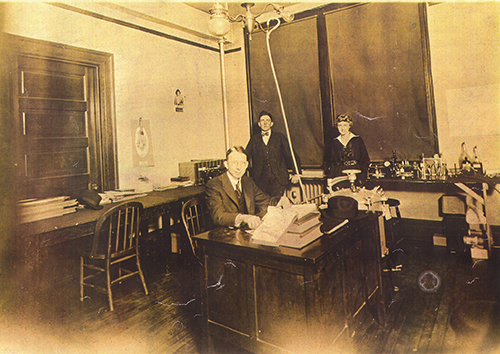 Dr. Carl A. GroteWhile Joseph Goldberger’s contributions to understanding and eradicating pellagra are well known, Carl A. Grote’s are not. Grote became Alabama’s first county public health official in February of 1914 in response to needs unfulfilled by simply having a state-wide health officer. His selection for this position came just as pellagra was becoming epidemic in Walker County. Also, deaths from pellagra peaked throughout Alabama in 1915, probably because a boll weevil infestation of the cotton crop that year devastated Alabama sharecroppers and tenant farmers.
Dr. Carl A. GroteWhile Joseph Goldberger’s contributions to understanding and eradicating pellagra are well known, Carl A. Grote’s are not. Grote became Alabama’s first county public health official in February of 1914 in response to needs unfulfilled by simply having a state-wide health officer. His selection for this position came just as pellagra was becoming epidemic in Walker County. Also, deaths from pellagra peaked throughout Alabama in 1915, probably because a boll weevil infestation of the cotton crop that year devastated Alabama sharecroppers and tenant farmers.
 Grote examines a young patient in Walker County, 1914-1918.Impressed by Goldberger’s nutritional deficiency theory and controlled-environment studies, Grote conducted his own empirical field study of pellagra in Walker County mining camps. In his seminal 1916 paper, Grote came to three key conclusions based upon his observations of two mining camps. Mike Flannery explains these conclusions in his historical study of Grote: “1) the disease was not etiologically racial or hereditary in nature; 2) there was a direct correlation between available income and incidents of the disease, and 3) diet appeared to offer the most likely explanation for its etiology and cure.” Flannery goes on to explain that these published findings predate the 1920 publication of Goldberger’s mill village studies by four years, and thus, “represent the first confirmation of the true demographic and etiological features of pellagra in actual community settings by a healthcare professional. Unfortunately, published one-time and only in Alabama’s state medical journal, Grote’s seminal work on pellagra was forgotten or ignored.”
Grote examines a young patient in Walker County, 1914-1918.Impressed by Goldberger’s nutritional deficiency theory and controlled-environment studies, Grote conducted his own empirical field study of pellagra in Walker County mining camps. In his seminal 1916 paper, Grote came to three key conclusions based upon his observations of two mining camps. Mike Flannery explains these conclusions in his historical study of Grote: “1) the disease was not etiologically racial or hereditary in nature; 2) there was a direct correlation between available income and incidents of the disease, and 3) diet appeared to offer the most likely explanation for its etiology and cure.” Flannery goes on to explain that these published findings predate the 1920 publication of Goldberger’s mill village studies by four years, and thus, “represent the first confirmation of the true demographic and etiological features of pellagra in actual community settings by a healthcare professional. Unfortunately, published one-time and only in Alabama’s state medical journal, Grote’s seminal work on pellagra was forgotten or ignored.”
Articles Related to the Work of Carl Grote
 Walker County public health work in a local school, 1914-1918.Flannery, Michael A. "Fighting Pellagra in Alabama: Carl A. Grote's Forgotten Contribution to Conquering a Southern Scourge"
Walker County public health work in a local school, 1914-1918.Flannery, Michael A. "Fighting Pellagra in Alabama: Carl A. Grote's Forgotten Contribution to Conquering a Southern Scourge"
This article places pellagra in Alabama in its historical context and discusses Dr. Carl Grote's seminal work as Walker County public health officer against the so-called "red death."
Grote, Carl A. “Full Time Health Officer Work in Walker County (Ala.).” Southern Medical Journal 8, no. 12 (Dec. 1915): 1058-1061.
Grote gives a description of his early work as Alabama’s first county health officer.
Grote, Carl A. “Pellagra: From the View Point of a County Health Officer.” Transactions of the Medical Association of the State of Alabama (April 1916): 332-337.
 Dr. Grote seated at the desk.Grote presents the first on-site field study of pellagra confirming its nutritionally-based etiology. The paper draws upon observations at two Walker County mining camps.
Dr. Grote seated at the desk.Grote presents the first on-site field study of pellagra confirming its nutritionally-based etiology. The paper draws upon observations at two Walker County mining camps.
Grote, Carl A. “Public Health Administration in a County Unit.” Transactions of the Medical Association of the State of Alabama (April 1918): 205-208.
This paper gives an overview of the challenges and opportunities Grote encountered as Alabama’s first public health officer.
